An Introduction to OM5: Wideband Multimode Fiber
Data centers are constantly moving toward faster speeds and higher densities – especially in hyperscale, Web 2.0 companies, such as Amazon, Google, Facebook, Apple and Microsoft. Speeds as high as 25G and 100G Ethernet have already become mainstream in data centers, and the industry is working collaboratively on next-generation Ethernet development, such as 200G and 400G Ethernet.
Multibmode fiber (MMF) is a cost-effective solution in these environments, thanks to its high tolerance for fiber misalignment and relatively low connection loss at each connector interface. Multimode fiber cabling systems – combined with LEDs and VCSEL (vertical-cavity surface-emitting laser)-based optical transceivers – are ideal for short-reach optical interconnects.
The channel capacity of multimode fiber has multiplied by using parallel transmission over several fiber strands (four or 16, with collections of 25 Gbps lanes carried in each direction). But this method raises cabling system prices.
The Problems with Multimode Fiber
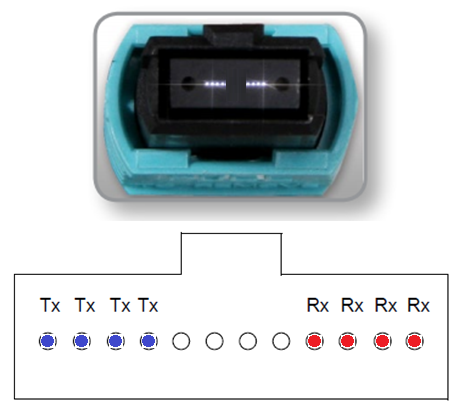
Initially developed to support Fast Ethernet (100BASE-FX and 1000BASE-SX), OM1 and OM2 multimode fiber cable can no longer support 10 Gbps and 25 Gbps data transmission speeds. In the ANSI/TIA-568.3-D Standard, OM1 and OM2 multimode fiber types have been “grandfathered” in, and are not recommended for new installations. (pictured at right: 100GBASE-SR4 (MPO-12))
Until recently, OM3 and OM4 (laser-optimized multimode fiber [LOMMF]) were the mainstream multimode fiber cabling choices to support 10G, 40G and 100G Ethernet, InfiniBand and Fibre Channel protocols.
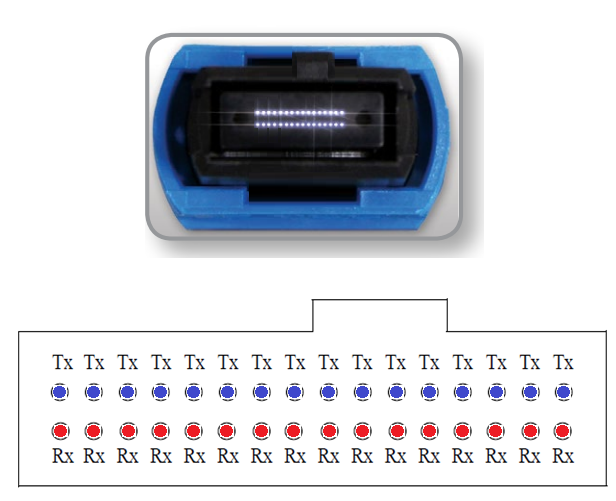
As bandwidth requirements increase much faster than the VCSEL-based transceiver technology curve, however, it’s becoming more costly for optical fiber cabling systems to support next-generation Ethernet speed migration. For example, in the IEEE 802.3bs Standard draft, 400GBASE-SR16 has been specified to reuse 100GBASE-SR4 technology, but it calls for a new MPO-32 connector instead of an MPO-12 connector. (pictred at right: 400GBASE-SR16 (MPO-32) Interface)
A Potential Alternative: Wideband Multimode Fiber
Wideband multimode fiber (WBMMF) is an ANSI/TIA development that can deal with escalating data rates and the infrastructure required to support higher bandwidth. It uses wavelengths to increase each fiber’s capacity by at least a factor of four, which allows at least a fourfold data-rate increase (or a fourfold reduction in the number of fibers required to achieve a given data rate. Instead of using four separate fibers to transmit four optical signals, the signals can be sent down one fiber over four separate operating windows.
ANSI/TIA-492AAAE, the new wideband multimode fiber standard, was approved for publication in June 2016 after a 20-month, industry-wide study carried out by a special TIA taskforce within TR-42.11 (Optical Systems Subcommittee) and TR-42.12 (Optical Fibers and Cables Subcommittee). The International Organization for Standardization/International Electrotechnical Commission (ISO/IEC) has recently decided on the nomenclature for wideband multimode fiber cable: OM5. This new fiber cable standard has already been referred to by the IEEE 802.3 working group for next-generation Ethernet standard development.
Please note that the TIA-492AAAE document specifies the raw glass fiber performance for the wideband operation, while ISO/IEC OM5 and TIA 568.3-D specify the cabled fiber performance containing the wideband multimode fiber.

Multimode Standard Specifications (Note: Standard In Progress)
The table above represents different multimode fiber standard specifications and their supported link distances for IEEE 802.3 Ethernet applications.
Wideband multimode fiber can support:
- Wavelength division multiplexing (WDM) across the 840-953nm wavelength range
- Backward compatibility with OM4 multimode fiber at 850nm
The effective modal bandwidth (EMB) – the maximum signaling rate for a given distance – of wideband multimode fiber has been defined to not only support the bitrate of 25.78125 Gbps, as specified in IEEE 802.3bm 100GBASE-SR4, but also to support 28.05 Gbps, as specified in the 32G Fibre Channel (32GFC) standard, both at 100m minimum reach across the entire wavelength range.
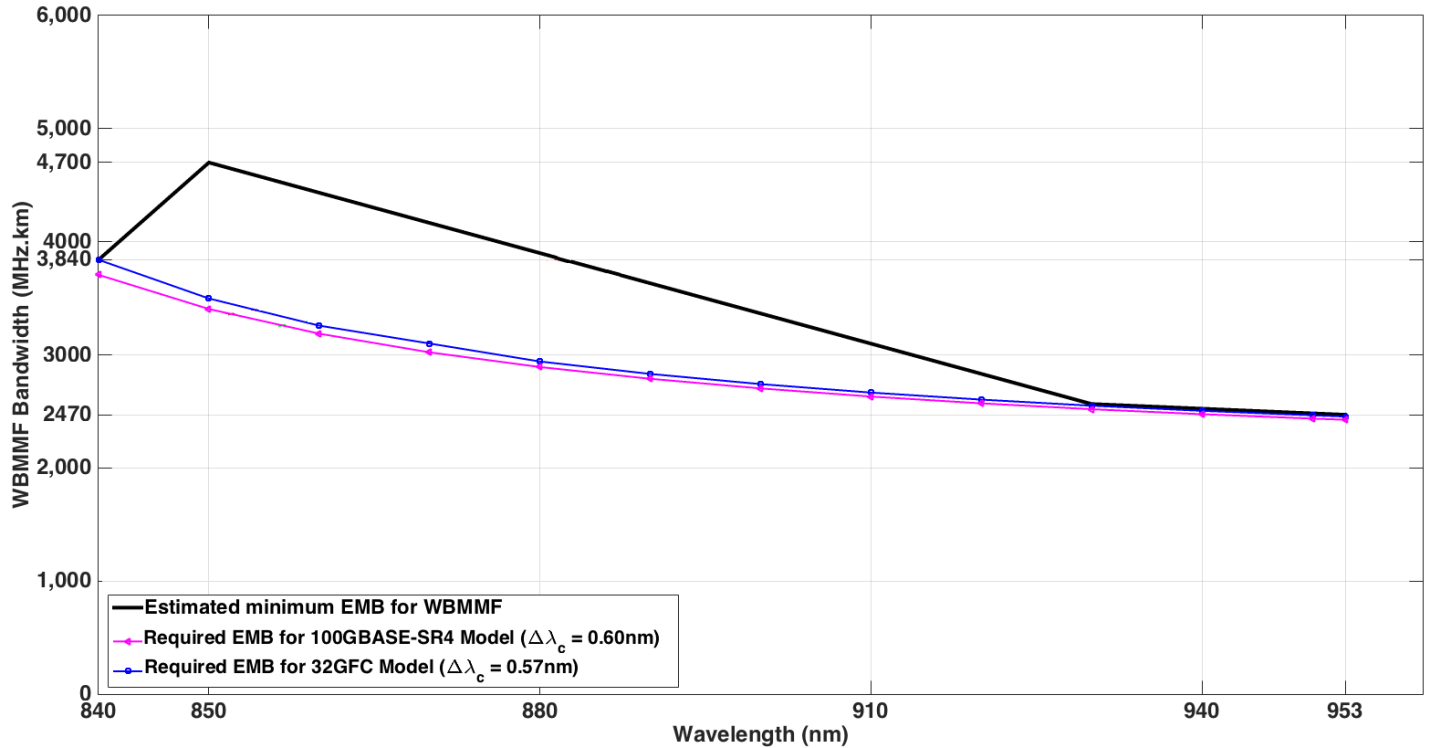
Minimum effective modal bandwidth for wideband mulitmode fiber as specified in ANTI/TIA-492AAAE
The figure above shows the minimum required EMB as specified in ANSI/TIA-492AAAE. In a multimode fiber link, data rate and maximum reach are limited by:
- Fiber cable attenuation (reduced signal strength) and connection loss
- Chromatic dispersion in the fiber (spreading out of light pulses over time due to different wavelengths traveling at different speeds)
- Modal bandwidth of the fiber
Because multimode fiber’s cable attenuation and chromatic dispersion are lower at higher wavelengths, the required minimum EMB is relatively lower at 953nm than at the 840nm end. The minimum EMB of wideband multimode fiber at 850nm is specified as the same value as for OM4 (4700MHz/km) to guarantee backward compatibility.
Other link impairment factors are also involved:
- VCSEL spectral width (Δλc) and rise-fall time
- Transmitter emission power
- Optical modulation amplitude (difference between twooptical power levels)
- Signal-to-noise ratio
- Sensitivity and bandwidth of the photo-detector
- Crosstalk from adjacent channels
These specifications are typically developed by IEEE 802.3 to ensure a technically feasible transceiver product with enough mass-production margin.
Short-Wavelength-Division-Multiplexing (SWDM) Applications
The parallel multimode fiber MPO cabling (pictured below in Figure 3) is considerably more costly than the multimode fiber LC-duplex patch cord (pictured below in Figure 4).
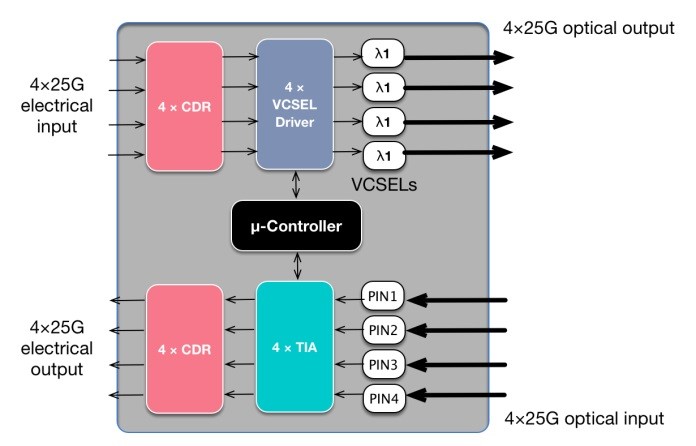
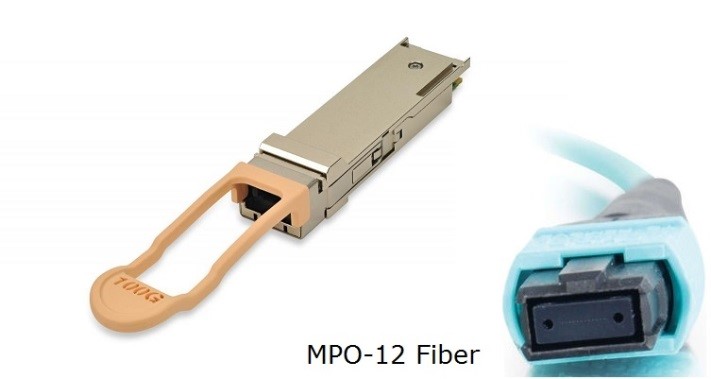
Left: 100G QSFP28-SR4 Transceiver
Right: MPO-12 Fiber


Left: 100G QSFP28-SWDM4
Right: LC-Duplex Fiber
To reduce costs in direct point-to-point connections, it’s more desirable to use a single pair of fiber instead of MPO trunks.
Using a single fiber to carry multiple wavelengths (wavelength division multiplexing [WDM]) isn’t a new concept, and has been widely used in the telecomm world to reduce singlemode fiber numbers. In short-reach datacomm applications, Cisco BiDi (bidirectional optical technology) and Arista Universal transceiver solutions using two and four wavelengths are also been proven to be market successes.
In 2015, the SWDM Alliance was formed by a group of transceiver, fiber and system vendors to develop a multisource agreement (MSA) for SWDM transceivers. Because OM5 wideband multimode fiber permits the use of a much wider wavelength range of 850nm to 953nm, it’s desirable to reduce fiber count by transmitting multiple VCSEL wavelengths in the same multimode fiber.
Potential wavelength grids are defined as 850nm (λ1), 880nm (λ2), 910nm (λ3) and 940nm (λ4), with a spacing of 30nm. Both 40G and 100G QSFP SWDM4 samples have been demonstrated; the target release date will be in early 2017.
We’ll keep you updated here as the development of wideband multimode fiber continues. Belden’s wideband multimode fiber solutions optimize fiber for increased bandwidth by using multiple wavelengths in the lower end of the spectrum. Learn more about the experience and expertise we can bring to reduce costs, improve uptime, make the best use of space and ensure security.
